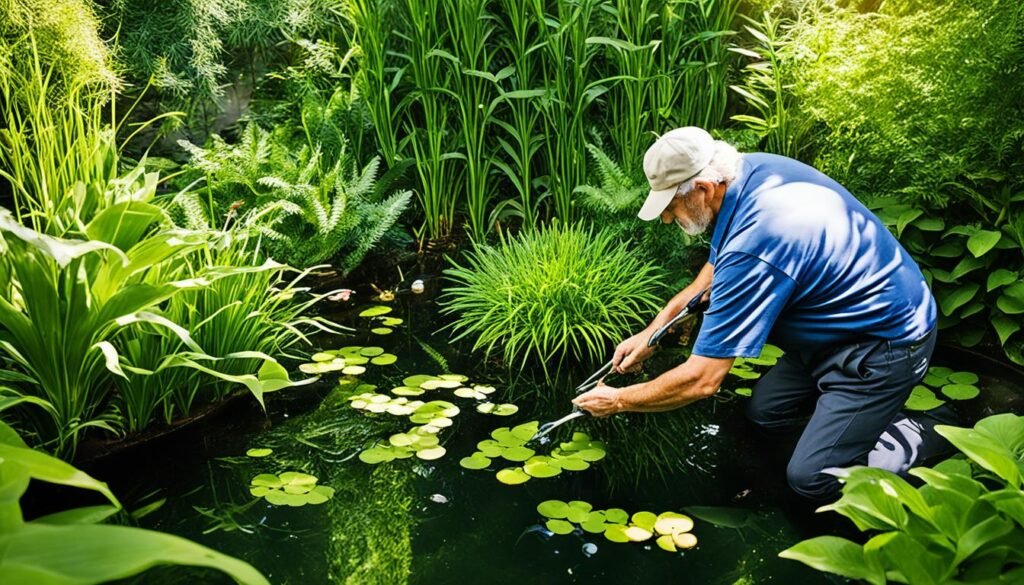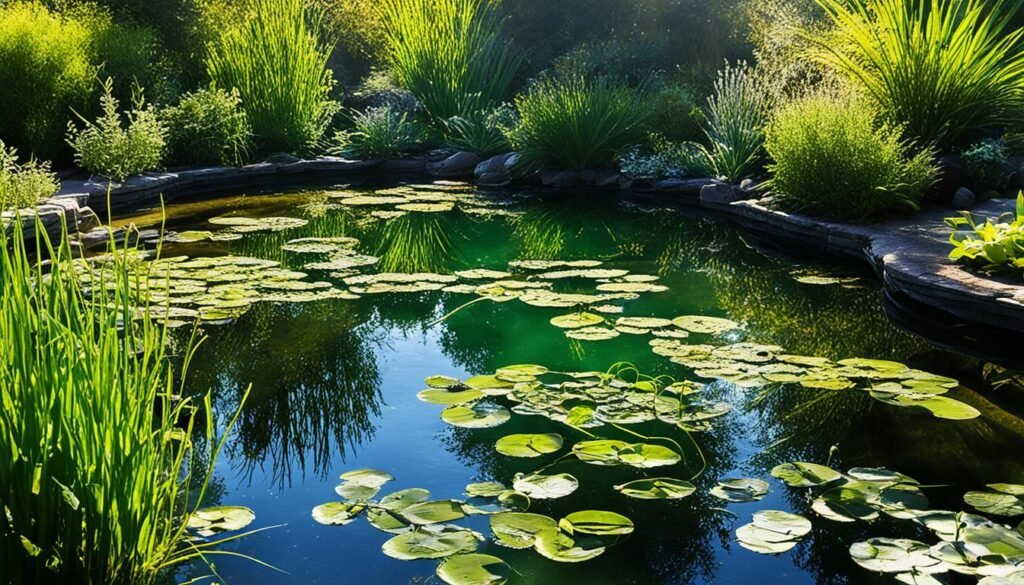I vividly recall the day that aquatic gardening first captured my interest. My neighbor’s pond, alive with diverse life, drew my attention. The lush greenery beneath the water’s surface caught my eye, revealing the importance of pond plant care and pruning.
Some of the links in this article may be affiliate links. If you make a purchase through these links, we may earn a small commission at no extra cost to you. Thank you.
My desire to replicate this aquatic haven led me to delve into water garden maintenance. I soon understood that the proper care of these plants is vital for a thriving ecosystem. From choosing the right species to learning pruning techniques, each step is crucial for a healthy, attractive pond.

Through practice in pond plant care and pruning, my backyard evolved into a peaceful sanctuary. The leaves’ soft rustle and the fish’s gentle splash became my summer evenings’ soundtrack. I’m now eager to share my knowledge with others, helping both enthusiasts and beginners in aquatic gardening.
Understanding the Importance of Aquatic Plants in Your Pond
Aquatic plants are crucial for pond health. They’re not just for aesthetics; they’re essential for a balanced pond ecosystem. Knowing their role can significantly impact your pond care.
Water Filtration and Oxygenation
Aquatic plants act as natural filters, absorbing excess nutrients to keep the water pristine. Through photosynthesis, they release oxygen, vital for fish and other aquatic life.
Habitat and Shelter for Aquatic Life
Plants offer safe havens for fish, protecting them from predators and providing a place to lay eggs. They also support a diverse range of insects and microorganisms, enriching your pond’s ecosystem.
Types of Aquatic Plants for Your Pond
Various aquatic plants can enhance your pond:
- Submerged plants like Anacharis grow underwater and help oxygenate the pond
- Floating plants such as Water Lilies provide shade and surface cover
- Marginal plants like Cattails thrive along the pond’s edges
- Deep-water plants like Pondweed grow in deeper areas of the pond
Adding a mix of these plants creates a balanced pond ecosystem. Effective pond vegetation management is crucial for a healthy aquatic environment for all inhabitants.
Selecting and Placing Pond Plants for Optimal Growth
Choosing the right aquatic plants is essential for pond landscaping. The success of aquatic plant selection hinges on several critical factors. Climate, sunlight exposure, and water depth are key in determining which plants will flourish in your pond.
I begin by considering the hardiness zone of my area. This ensures I select plants that can endure local weather. Then, I evaluate the light conditions around my pond. Some plants flourish in full sun, while others prefer partial shade.
Water depth is another crucial element in pond landscaping. I establish distinct plant zones to suit various aquatic vegetation types:
- Submerged zone: For deep-water and oxygenating plants
- Marginal zone: Ideal for transitional plants
- Floating zone: Perfect for surface coverage plants
I prefer using aquatic plant baskets or plastic pots with drainage holes for containers. These allow for proper root growth and nutrient uptake. When planning my pond’s layout, I meticulously consider each plant’s mature height, spread, and preferred water depth.
For newcomers to aquatic plant selection, I suggest starting with easy-to-grow species. This approach fosters a balanced ecosystem and enhances the visual appeal of your pond landscape.
Successful pond landscaping is about achieving harmony between plants and their environment. By taking these factors into account, you’ll be well on your way to cultivating a vibrant aquatic garden.
Pond Plant Care and Pruning: Essential Techniques
Regular care and pruning are vital for keeping pond plants in excellent condition. Mastering aquatic plant pruning techniques is crucial for a thriving pond ecosystem. Let’s explore key methods for trimming underwater plants and maintaining a vibrant aquatic garden.
Pruning Different Types of Aquatic Plants
Each pond plant type requires unique care. For water lilies, I remove brown leaves and divide the plant every few years. Flag irises need annual pruning in fall, cutting back yellowed leaves about 8 inches above the ground. Oxygen plants are trimmed to half their size, with angled cuts on the stems.
Tools and Methods for Effective Pruning
Choosing the right tools is essential for pond plant grooming. I use sharp scissors or pruning shears for clean cuts. This method prevents damage and encourages healthy regrowth. Always sanitize your tools before and after use to prevent disease spread between plants.
Seasonal Pruning Guidelines
Timing is crucial in pond maintenance. I perform major pruning in spring or early summer when plants are actively growing. Throughout the season, I do light maintenance to keep plants in check. This strategy ensures my pond remains balanced and attractive all year.
| Season | Pruning Task |
|---|---|
| Spring | Major pruning, remove winter damage |
| Summer | Light maintenance, trim excess growth |
| Fall | Prepare plants for winter, remove dead foliage |
| Winter | Minimal pruning, focus on protection |
By adhering to these pond plant care and pruning guidelines, you’ll cultivate a vibrant aquatic environment. Regular maintenance ensures your pond remains healthy, beautiful, and balanced throughout the year.
Maintaining Water Quality for Healthy Pond Plants
Water quality is crucial for Maintaining Healthy Pond Flora. As a pond owner, I’ve discovered that proper Water Garden Maintenance is vital for aquatic plants to flourish. Let’s explore the essential steps to keep your pond water pristine.

Nutrient Management in Your Pond
It’s essential to balance nutrients for plant health. I test my pond water for nitrogen and phosphorus levels regularly. Excessive levels can cause algae blooms, while deficiencies can stunt plant growth. In spring, I use aquatic plant fertilizers to boost my plants.
pH Balance and Its Impact on Plant Health
Most pond plants prefer slightly acidic to neutral water. I monitor my pond’s pH weekly and adjust it as necessary. Limestone can raise pH, while peat moss lowers it. Keeping the pH between 6.5 and 7.5 ensures optimal nutrient uptake for my aquatic plants.
Algae Control Strategies
Algae can be a major challenge for pond owners. I manage it effectively by:
- Maintaining 60-70% plant coverage to shade the water
- Removing debris and fallen leaves promptly
- Using beneficial bacteria to break down organic matter
- Installing a UV clarifier for stubborn algae issues
By focusing on these Water Garden Maintenance strategies, I’ve created a thriving ecosystem for my pond plants. A balanced approach is crucial for Maintaining Healthy Pond Flora throughout the year.
Overwintering Your Pond Plants: Tips for Year-Round Care
As autumn approaches, I start preparing my pond for the colder months. Pond plant care and pruning become crucial during this time. I trim back submerged plants to prevent excessive decay and remove floating plants, storing them indoors or in a heated greenhouse. This aquatic gardening practice helps maintain a healthy ecosystem year-round.
For marginal plants, I lower them to deeper water to protect from freezing. Tropical varieties require special attention – I either move them indoors or provide insulation. To ensure oxygen exchange for plants and fish, I install a pond de-icer or aerator, maintaining an opening in the ice.
Autumn brings fallen leaves, so I use netting to keep them out of the pond. This simple step prevents water quality issues and reduces spring cleanup. During winter dormancy, I adjust my maintenance routines, focusing on minimal care to support the pond’s ecosystem.
- Trim submerged plants
- Remove and store floating plants
- Lower marginal plants
- Protect tropical varieties
- Install de-icer or aerator
- Use netting for leaf control
By following these overwintering practices, I ensure my pond plants survive the cold months and thrive when spring returns. This approach to pond plant care and pruning allows me to enjoy beautiful aquatic gardening year after year.
Conclusion: Cultivating a Thriving Pond Ecosystem
Creating a vibrant pond ecosystem is akin to tending to a living work of art. By selecting and placing aquatic plants with care, I foster a balanced environment. This environment is both beautiful and self-sustaining. Regular pruning and care keep my pond plants healthy, supporting the entire aquatic community.
Water quality management is crucial for pond ecosystem balance. I monitor nutrients, pH levels, and algae growth to maintain crystal-clear water and thriving plants. This attention to detail not only enhances the pond’s appearance but also creates a haven for fish, frogs, and other aquatic creatures.
My journey into aquatic gardening has been rewarding. With each season, I discover new ways to nurture my pond’s ecosystem. From winter protection to summer pruning, these essential care practices ensure my pond remains a focal point in my outdoor space year-round. By following these tips, I’ve created a low-maintenance oasis that brings joy and natural beauty to my backyard.
FAQ
Why is it important to prune aquatic plants in my pond?
Pruning is crucial for keeping aquatic plants vibrant and healthy. It encourages new growth, prevents diseases, and maintains a balanced pond ecosystem. This practice ensures your pond remains a thriving environment.
What are the roles of aquatic plants in a pond ecosystem?
Aquatic plants are essential for water filtration, oxygen production, and providing shelter for pond life. They help keep the water clear and prevent algae from taking over. This balance is vital for a healthy pond.
How do I choose the right aquatic plants for my pond?
Selecting the right aquatic plants involves considering your climate, sunlight exposure, and water depth. Ensure the plants match your region’s hardiness zone and the pond’s specific conditions. Organize plants into zones like submerged, marginal, and floating for best growth.
What pruning techniques should I use for different types of aquatic plants?
Different plants require specific pruning methods. For instance, water lilies need trimming every four years, while flag irises should be pruned annually in autumn. Oxygenating plants should be cut back to half their size. Always use sharp tools for clean cuts.
How do I maintain proper water quality for healthy pond plants?
To keep water quality high, monitor and manage nutrient levels, adjust the pH regularly, and balance the ecosystem to control algae. Remove debris and consider using fertilizers or beneficial bacteria. This approach is key to supporting plant health.
How should I prepare my pond plants for winter?
For winter, trim back submerged plants and remove floating ones. Lower marginal plants to deeper water and insulate or bring tropical plants inside. Installing a de-icer or aerator ensures oxygen exchange during the winter months.

